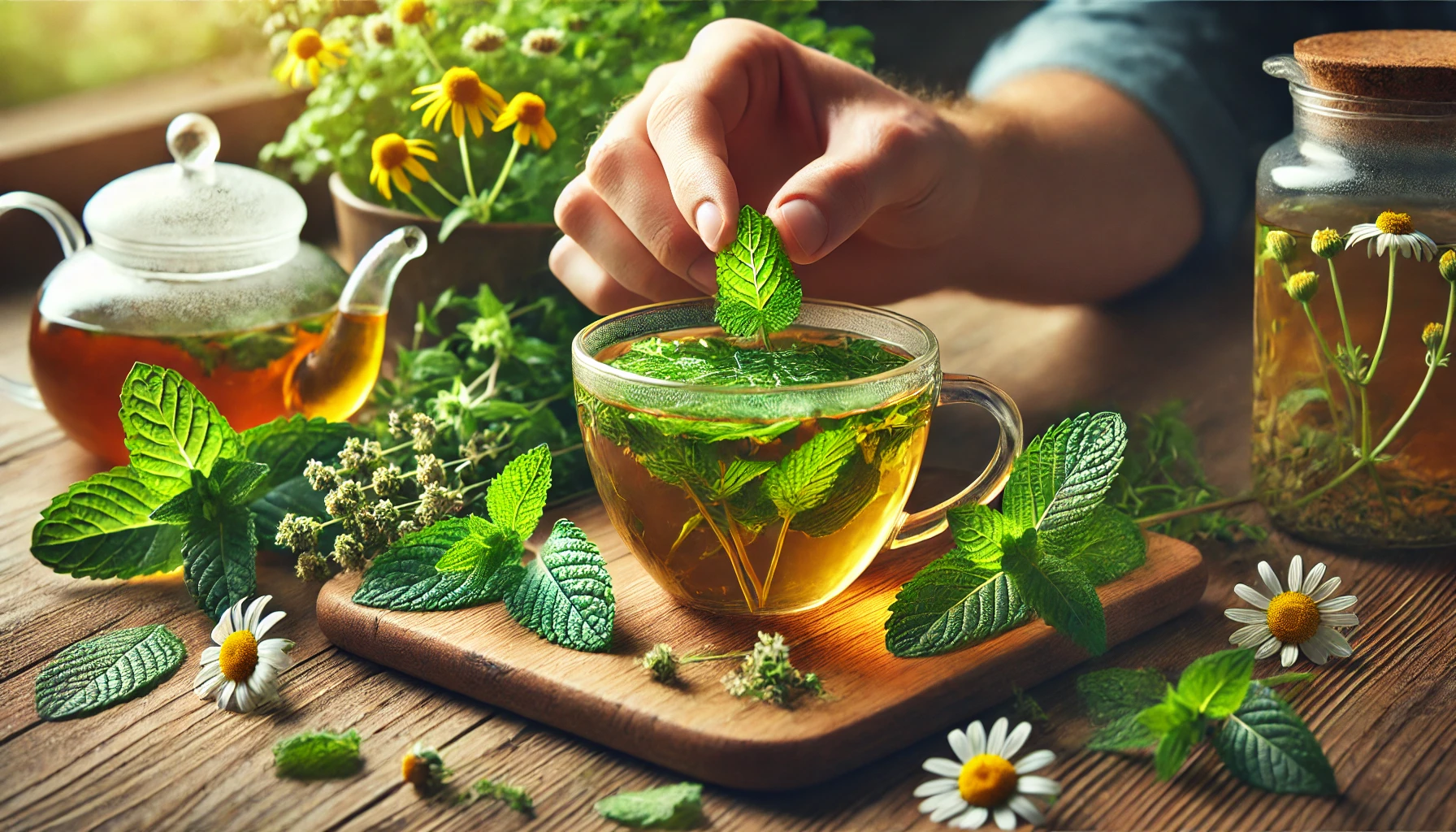Drinking herbal tea made from fresh, homegrown herbs is a delightful way to enjoy natural flavors while benefiting from the therapeutic properties of plants. Unlike store-bought tea bags, fresh herbs offer more intense aromas, richer flavors, and higher nutritional value.
Whether you’re growing herbs on a balcony, windowsill, or garden, this guide will show you how to harvest, prepare, and brew herbal teas for maximum freshness and health benefits.
Why Use Fresh Herbs for Tea?
1. Better Flavor and Aroma
Fresh herbs contain higher levels of essential oils, making the tea more fragrant and flavorful compared to dried herbs.
2. Higher Nutrient Content
Since fresh herbs haven’t been processed or stored for long periods, they retain more vitamins, antioxidants, and beneficial plant compounds.
3. Customizable Blends
Growing your own herbs lets you experiment with different flavors and health benefits, creating unique tea blends tailored to your taste and needs.
Best Herbs for Fresh Herbal Tea
Some herbs are particularly well-suited for fresh tea, offering a variety of flavors and benefits.
1. Mint (Peppermint & Spearmint)
- Flavor: Cool, refreshing, slightly sweet.
- Benefits: Aids digestion, relieves headaches, soothes nausea.
2. Lemon Balm
- Flavor: Mild lemony taste with a hint of mint.
- Benefits: Reduces stress, improves sleep, supports digestion.
3. Chamomile
- Flavor: Sweet, floral, apple-like aroma.
- Benefits: Calming, helps with sleep and digestion.
4. Basil (Holy Basil/Tulsi & Sweet Basil)
- Flavor: Slightly spicy, earthy, and aromatic.
- Benefits: Supports the immune system, reduces stress, aids digestion.
5. Lavender
- Flavor: Floral with earthy and citrus notes.
- Benefits: Promotes relaxation, helps with anxiety and sleep.
6. Rosemary
- Flavor: Pine-like with a hint of citrus.
- Benefits: Boosts memory, improves circulation, supports digestion.
7. Thyme
- Flavor: Earthy, slightly peppery, and herbal.
- Benefits: Soothes coughs, supports respiratory health, boosts immunity.
8. Sage
- Flavor: Warm, slightly bitter, with a deep herbal taste.
- Benefits: Supports memory, aids digestion, relieves sore throats.
9. Ginger (Fresh Root Herb)
- Flavor: Spicy, warming, with a citrus undertone.
- Benefits: Relieves nausea, reduces inflammation, improves circulation.
10. Lemongrass
- Flavor: Bright, lemony, slightly sweet.
- Benefits: Reduces stress, supports digestion, relieves bloating.
How to Harvest Fresh Herbs for Tea
1. Choose the Best Time to Harvest
- Pick herbs in the morning, after the dew has dried but before the heat of the day.
- This is when essential oils are at their highest concentration, giving the best flavor and aroma.
2. Use Sharp Scissors or Pruning Shears
- Cut just above a leaf node to encourage more growth.
- Avoid tearing or pulling leaves, as this can damage the plant.
3. Harvest Only What You Need
- Fresh herbs taste best when used immediately after picking.
- If you need to store them, wrap them in a damp paper towel and refrigerate for up to 5 days.
How to Prepare Fresh Herbs for Tea
1. Wash the Herbs Gently
- Rinse herbs under cool running water to remove dirt and insects.
- Pat dry with a clean towel or let them air dry for a few minutes.
2. Chop or Tear the Leaves
- Lightly crushing or tearing the leaves releases more essential oils, enhancing the flavor.
- For tougher herbs like rosemary or thyme, bruise the leaves slightly with a mortar and pestle.
How to Brew Fresh Herbal Tea
1. Simple Hot Infusion (Best for Most Herbs)
- Ratio: Use 1-2 tablespoons of fresh herbs per 8 ounces (1 cup) of hot water.
- Water Temperature:
- Delicate herbs (mint, lemon balm, chamomile) – 175°F (80°C) (just below boiling).
- Woody herbs (rosemary, thyme, sage) – 200°F (93°C) (almost boiling).
- Steeping Time:
- Soft herbs: 5-7 minutes.
- Woody herbs: 8-10 minutes.
- Strain and enjoy!
2. Cold Brew Herbal Tea (Best for Heat-Sensitive Herbs)
- Fill a jar with fresh herbs and cold water (same ratio as above).
- Cover and refrigerate for 8-12 hours for a refreshing, subtle tea.
- Strain before serving.
3. Herbal Tea Blends
Try mixing herbs for unique flavors and benefits:
- Relaxation Blend: Chamomile + Lavender + Lemon Balm.
- Digestive Support: Peppermint + Ginger + Fennel.
- Immune Boost: Rosemary + Thyme + Sage.
- Energizing Blend: Basil + Lemongrass + Green Tea.
Enhancing Your Herbal Tea
1. Natural Sweeteners
- Honey – Soothes the throat and enhances floral flavors.
- Maple Syrup – Adds a light caramel sweetness.
- Stevia Leaves – A natural, sugar-free alternative.
2. Citrus & Fruit Additions
- Lemon slices – Brightens herbal flavors.
- Orange peel – Adds natural sweetness.
- Berries – Provides a fruity twist to herbal blends.
3. Spices for Depth
- Cinnamon – Pairs well with mint, basil, and ginger.
- Cloves – Adds warmth and spice to rosemary and thyme teas.
- Nutmeg – Complements chamomile and lavender.
How to Store Fresh Herbs for Future Use
Short-Term Storage (Up to 5 Days)
- Wrap herbs in a damp paper towel and store in a resealable plastic bag in the fridge.
Drying Herbs for Long-Term Use
- Air Drying: Hang herbs upside down in a dark, dry place for 1-2 weeks.
- Oven Drying: Bake at 100-120°F (40-50°C) for 2-3 hours.
- Dehydrator: Dry at 95°F (35°C) for 12-24 hours.
Freezing Fresh Herbs
- Chop fresh herbs, place them in an ice cube tray, and cover with water.
- Freeze and use cubes in tea for a fresh herbal infusion anytime.
Conclusion: Enjoying the Perfect Herbal Tea from Fresh Homegrown Herbs
Making herbal tea with fresh, homegrown herbs is an easy, enjoyable, and healthy way to enjoy nature’s best flavors. By growing, harvesting, and blending your own herbs, you can create unique, delicious teas that suit your taste and wellness goals. Whether you prefer a calming chamomile blend or an energizing mint infusion, fresh herbal tea is a simple pleasure that brings both relaxation and health benefits.

